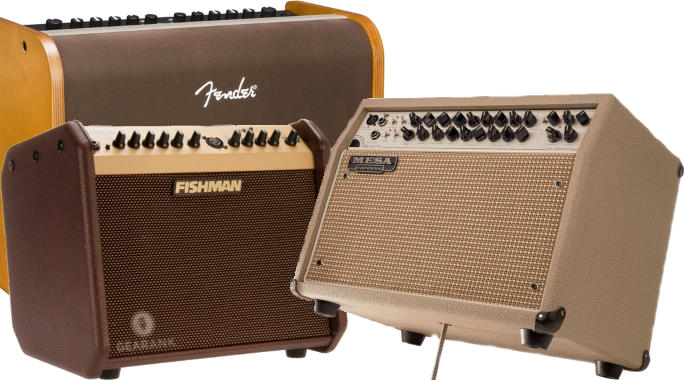
Achieve better sound, volume, and flexibility with the right acoustic guitar amp. Thoroughly researched list of the best acoustic guitar amps to fit your budget.
Disclosure
We recommend all products independently of 3rd parties including advertisers. We earn advertising fees from:
• • • • •

• • • • •
Amazon
As an Amazon Associate we earn from qualifying purchases.
• • • • •
More Acoustic Guides
Acoustic guitar amps have improved their technology with capabilities that emulate the woody and percussive sound of a miked guitar. These specialized acoustic guitar amps have extended frequency response that captures this. These amps must also be transparent to faithfully reproduce acoustic instruments’ dynamics, attack, and sonic nuances.
In this edition, we feature the best acoustic guitar amp options on the market, based on actual user feedback including the most recent reviews and ratings. The amps are grouped based on price to make it easier for the discerning acoustic guitarist to see which ones fit your planned budget.
Two-channel acoustic amps continue to be the mainstay of this category, they usually have a mic input in addition to the acoustic guitar input. This configuration makes it a pseudo PA system, suitable for singer-guitarists. Many of these amps come with HF drivers (tweeters) to better handle the high frequencies of acoustic instruments and even vocals. And this “full-range” tweeter plus woofer configuration is the reason why acoustic guitar amps are closer to PA speakers than conventional electric guitar amps.
The Best Acoustic Guitar Amps – 2024
| Gearank* | SRC* | Check Price | ||||||
|---|---|---|---|---|---|---|---|---|
| Under $200 | ||||||||
 | Fender Acoustasonic 15 | 91 | 1800+ | |||||
| $200 to $500 | ||||||||
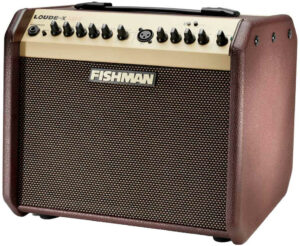 | Fishman Loudbox Mini BT | 97 | 950+ | |||||
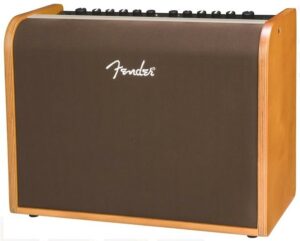 | Fender Acoustic 100 | 93 | 500+ | |||||
| $500 to $1000 | ||||||||
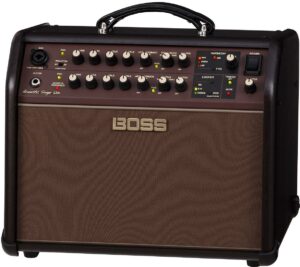 | Boss Acoustic Singer Live | 93 | 325+ | |||||
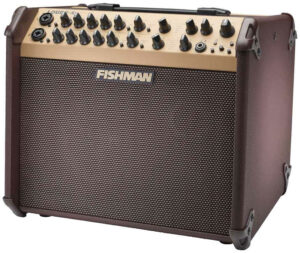 | Fishman Loudbox Artist BT | 95 | 325+ | |||||
| Over $1000 | ||||||||
 | AER Compact 60/4 | 95 | 100+ | |||||
 | AER Alpha | 92 | 70+ | |||||
The Best Acoustic Amp Under $200
Fender Acoustasonic 15
Cons
- Low volume
- Mic channel has limited controls
- Would've been nice if it could run on batteries
Pros
- Good clean sound with mid-high emphasis
- 2 Channel (Mic & Instrument)
- Compact and portable
- Bedroom and practice friendly volume
The Fender Acoustasonic 15 is a portable and affordable acoustic combo amplifier, it is a 15W combo with a 6" woofer.
Even with its small design, Fender was still able to outfit the amp with 2-channels, one for mic, and the other for acoustic-electric guitar. This makes the Acoustasonic 15 viable as a low-wattage portable PA system. It's an ideal fit for students who play the acoustic guitar and sing simultaneously
Vocal Channel 1 sports an XLR input jack for mic, and a dedicated volume knob. Channel 2 has a 1/4" input for instrument, with volume and 3-band EQ that includes bass, middle, and treble control knobs. The 3-band EQ allows for shaping the tone of your acoustic guitar. Channel 2 also comes with a chorus knob, which is an interesting choice, given that most amp manufacturers usually go for reverb.
Given its 6" woofer and traditional cabinet design, don't expect much low-end, but it does a good job of reproducing the highs and mids. The resulting sound is clean with some emphasis on the mid-treble.
For a 15W amp, it has sufficient volume for small rooms, but it works best when set to lower volumes for practice. Acoustic amps at this wattage also sound more pleasing at these volumes. Though, with its limited projection and power, this is not ideal for stages. But thanks to these limitations, the amp is portable and lightweight - it would've been nice if it could run on batteries.
Interestingly, the amp comes equipped with a 1/4" headphones out, which is quite awkward because acoustic guitars will still be loud even when you're using headphones.
The Fender Acoustasonic 15 is one of the best acoustic guitar amps. It is a great budget friendly amplifier for acoustic guitar, backed by an established guitar brand. It is highly recommended at this price point.
Features
- Two Channel 15W
- Compact Profile 6" Speaker
- Built-in Chorus
Specifications
- Power Rating: 15 Watts
- Amplifier Type: Solid State
- Channels: 2
- Master Volume: Yes
- Inputs: 1 x XLR, 1 x 1/4"
- Outputs: 1/4" (Headphones)
- Controls: Ch1 - Volume, Ch2 - Volume, Bass, Middle, Treble, Chorus
- Speakers: 1 x 6"
- Weight: 10.5 lbs
- Dimensions: 11.5" x 11.19" x 7.13"
| Website | Source | *Rating Value |
| YouTube | Synths and Guitars | 93/100 |
| Guitar Squid | Russel Wolfe | 87/100 |
Best Amps for Acoustic Guitars Under $500
Fishman Loudbox Mini BT
Cons
- Not meant to be driven too hard
- Small woofer, bass lacks depth
Pros
- Full range speaker system with tweeter
- 2-Channel (Mic and Instrument)
- Modern Bluetooth convenience
- Viable all-around multimedia speaker
The Fishman Loudbox Mini BT adds Bluetooth wireless connectivity to its already successful predecessor, while carrying over the same balance of power, tone, and portability. This means that you get the benefit of modern wireless audio streaming on an amp that you can use with your acoustic-electric guitar.
Weighing in at 21 lbs., it sports 2-channels--one allows for 1/4-inch cables and the other for XLR. It has a 6.5" LF woofer, and a 1.1"HF tweeter, both of which work together to give this amp extended frequency range. The tweeters allow the amp to reproduce the crisp attack of acoustic guitars, resulting in a more natural sound. Given the small woofers, bass doesn't go deep, but it has enough for acoustic-electric guitar use.
This 60W amp can go loud, enough to cover small venue gigs. It's great as it doesn't get overpowered by the number of instruments in practice and group rehearsals. The extra power and the tweeter make this a good mic amp as well. And when you consider the addition of Bluetooth connectivity, this acoustic amp can become a capable mini-PA system and all-around multimedia wireless speaker. In this day and age, wireless connectivity has become more of a necessity than a luxury feature.
Note that while the amp has quite the headroom, the small speaker it has means that you're not supposed to drive the two channels too hard. On the other hand, this smaller speaker ups its portability. Other features include built-in chorus and reverb, and it has an XLR DI output for recording or for plugging into a PA system.
The Fishman Loudbox Mini BT is a premium sounding multi-channel acoustic amp with wireless Bluetooth convenience and good portability.
Features
- Full Range Speaker: 6.5" Woofer and 1.1" Tweeter
- Dual Channel with 3-Band EQ
- Built-in Reverb & Chorus
- Bluetooth Connectivity
- XLR DI Out
Specifications
- Power Rating: 60 Watts
- Amplifier Type: Solid State
- Channels: 2
- Master Volume: Yes
- Inputs: 1 x 1/4", 1 x XLR (Mic), 1 x 1/8" (Aux), 1 x 1/4" (Aux)
- Outputs: 3-band EQ (Instrument), 2-band EQ (Mic)
- Controls: Dedicated Gain, Low, High, and Reverb knobs for each channel, Mid and Chorus knobs for Guitar Channel, Master Volume, Phase, Bluetooth Pairing
- Speakers: 1 x 6.5" LF Woofer, 1 x 1" HF Tweeter
- Weight: 21 lbs
- Dimensions: 12" x 13.7" x 9.7"
| Website | Source | *Rating Value |
| Acoustic Life | Tony Polecastro | 94/100 |
| Guitar Interactive | Editor | 100/100 |
Fender Acoustic 100
Cons
- Can be too trebly
- Not meant to be cranked hard
Pros
- 2 Channels with dedicated Acoustic Guitar EQ and effects
- More effects selection
- Full range sound via whizzer cone
- Bluetooth connectivity
- USB direct recording
- Well thought out design
The Fender Acoustic 100 is an acoustic amp that combines modern features with elegant looks.
Like most acoustic guitar amps, it has 2 channels, but the extra channel is no longer just an afterthought, both channels have the same input, controls, and features. Each channel has a dedicated Combo XLR input, for plugging in a microphone or an instrument.
And the two channels have dedicated controls including: phase shift, 3-band EQ, FX selector, and FX level. The FX selector in particular offers a lot more effects than you'd expect from an acoustic amp, covering reverb, delay, chorus, vibratone, and combinations.
This means that you can apply different EQ and effects to each channel, which makes the amp great for using two different sound sources, be it a mic and guitar or two different instruments. It can even be good for blending two different pickups from one guitar.
Another interesting feature of this amp is its 8" Whizzer cone. It is basically a tweeter that's built into the woofer, providing increased high frequency response, much like a tweeter, but without taking as much space. As such, it behaves much like a full-range speaker system, with more treble definition than conventional woofer only combo amps. This whizzer cone helps give the amp a more natural sound, especially in the highs. The downside is that it could be too trebly for those who prefer warm bassy tones.
Rated at 100 Watts, this amp can go loud, but with its small 8" woofer - it's not meant to be cranked hard. It also makes sense that you don't max out the headroom since acoustic guitar amps are designed to provide clean tone.
All these nice features are packed inside a stylish-looking combo cabinet that gives it a premium furniture vibe. It also makes it stand out from other acoustic guitar amps in the market. Compared to traditional combo amps, the Fender Acoustic 100 design and aesthetics are well thought out, controls are cleverly hidden from the audience but accessible to the musician, and it comes complete with an integrated handle.
Contrasting its classic furniture appeal, it features modern enhancements which include Bluetooth connectivity and USB output for direct recording. These enhancements expand the use of the amp, making it viable as a wireless home speaker system and a USB audio interface.
The Fender Acoustic 100 is ideal for those who want a slick looking versatile modern acoustic amp.
Features
- Full Range Speaker: 8" Whizzer Cone
- Dual Channel with 3-Band EQ
- Built-in Effects: Chorus, Reverb, Delay, Tape Echo, Vibratone
- USB and Bluetooth Connectivity
- XLR DI Stereo Out
- Plywood shell
Specifications
- Power Rating: 100 Watts
- Amplifier Type: Solid State
- Channels: 2
- Master Volume: Yes
- Inputs: 2 x XLR-1/4" combo (mic/instrument), 1 x 1/8" (aux)
- Outputs: 2 x XLR (line out), 1 x 1/8" Headphones,
- Controls: Volume, 3-Band EQ, FX Level, FX Select, and Phase (Per Channel)
- Speakers: 1 x 8" speaker with whizzer cone
- Weight: 17.6 lbs
- Dimensions: 14" x 18.5" x 9.25"
| Website | Source | *Rating Value |
| Mixdown | Editor | 95/100 |
Best Acoustic Guitar Amp Recommendations Under $1000
Boss Acoustic Singer Live
Cons
- Looper is only 40 seconds
Pros
- Great pristine sound
- Harmonizer is very responsive
- Channel effects can be controlled independently
Microphone-ready amplifiers are becoming common in busking and gig settings. Boss Acoustic Singer Live takes it a step further with its built-in vocal effects and looper functionality.
The looper is short at around 40 seconds but is enough to develop musical ideas on the fly. The vocal effects included are based on Boss’ VE-8 Acoustic Singer pedal, which allows for many types of effects including smart real-time vocal harmonies. It goes along with the chords you’re playing on your guitar and it does it well.
It also features Boss’ Acoustic Resonance effect which adds fullness and depth to the resulting sound to make it sound more similar to a miked acoustic.
It also comes equipped with essential input/output options, including Aux input with level control, phantom power option for mics, separate DI outputs for voice and guitar, and USB audio interface functionality.
The amp is rated at 60 Watts and comes with two pairs of 6.5″ woofers and 1″ tweeters.
Features
- Bi-amp design with 6.5" woofer and 1" dome tweeter
- Dual channels with three-band EQ, independent anti-feedback control on each
- Built-in Effects: Indepenent Chorus, Reverb, and Delay/Echo
- Built-in looper
- 24-volt Phantom Power for condenser mics
- Dual XLR DI jacks
- Power Rating:60 Watts
- Amplifier Type: Solid State
- Channels: 2
- Master Volume: Yes
- Inputs: 1 x 1/4″ Guitar Input, 1 x Combo XLR (Mic/Line In), 1 x 1/8″ Aux Input
- Outputs: 2 x XLR (DI/line out)
- Controls: Per Channel Volume, 3-Band EQ, Anti-Feedback, Phase, Reverb), Delay/Echo Mic: Harmony, Echo/Delay Guitar: Chorus, Looper
- Speakers: 1 x 6.5” Woofer, 2 x 1″ Dome Tweeter
- Weight: 23.18 lbs
- Dimensions: 12.37” x 14.5” x 10.81”
Specifications
Fishman Loudbox Artist BT
Cons
- A little too trebly
- Effects don't sound as good as the amp
Pros
- Crisp and clear tone
- With switchable tweeter
- 120W gig ready power and features
- Independent 2-channel controls
- Expanded connectivity options
Fishman is known as the go-to acoustic pickup maker for many guitarists and guitar manufacturers. So it only follows that they know what a good acoustic amplifier should be like. The Loudbox Artist BT is one of their best rated offerings, a gig-ready 120W combo amp,
120 Watts of power along with a 1 x 8" woofer and 1 x 1" tweeter add up to give this amp more than enough volume for most small to medium sized venues. Even against larger acoustic guitar amps in this price range, it does all this while still being reasonably portable. More importantly, the tweeter really helps in giving it Fishman's signature crisp and clear tones.
The highs are very detailed, emphasizing percussive attack on the strings. And since it has a lot of headroom, the amp can go really loud without muddying up the sound. To cater to those who are into warmer tones, Fishman equipped this amp with a tweeter button. This turns off the tweeter to make the amp sound more like a traditional woofer only combo amp.
It follows a 2-channel format, with dedicated combo XLR input and controls. This means that there is no better channel, both have the same features and parameters so you can tweak each channel differently. This means that you have different settings that suit different inputs, be it an acoustic guitar, keyboard, violin, mic and more. Factor in its 24V phantom power option, and you have a full pledged mini-PA system.
The Loudbox Artist BT comes packed with various effects, including different types of reverb and delay, along with chorus and flanger. The built-in reverb effect sounds nice, very useful when playing outside. The other effects are unfortunately not as good, but at least they are there when you need them. This iteration improves on its predecessor by adding Bluetooth streaming functionality, a feature that is becoming standard on most modern amplifiers.
If you're looking for a gig-ready 2-channel acoustic amp, then the Fishman Loudbox Artist BT is one of the best acoustic guitar amplifiers in the market today.
Features
- Full Range Speaker: 8" Woofer and 1" Tweeter
- Dual Channel with 3-Band EQ, Anti-Feedback, Phase
- Built-in Effects: Chorus, Reverb, Delay, Flanger
- Bluetooth Connectivity
- 24-volt Phantom Power for Condenser Mics
- XLR DI Out and Effects Loop
Specifications
- Power Rating: 120 Watts
- Amplifier Type: Solid State
- Channels: 2
- Master Volume: Yes
- Inputs: 2 x XLR-1/4" combo (mic/instrument), 1 x 1/4" (aux), 1 x 1/8" (aux)
- Outputs: 1 x XLR (mix DI out), 2 x XLR (pre-EQ DI out)
- Controls: Gain, Low, Mid, High, Anti-Feedback, Effect Level, Effect, Pad, Phase, Effect B - Per Channel. Master, Effect A Type, Effect B Type, Time, Depth, Aux Level, 24V Phantom, Bluetooth Pairing, Tweeter, Mute
- Speakers: 1 x 8" woofer, 1 x 1" soft dome tweeter
- Weight: 25.5 lbs
- Dimensions: 13.5" x 15.5" x 11.5"
Top Rated Premium Amps for Acoustic Guitars Over $1000
AER Compact 60/4
Cons
- Lacks anti-feedback control
- No modern features
Pros
- Sounds big and loud for its compact size
- Detailed highs and lows
- Compact and portable profile
- Stage ready input and output options
AER is well known among acoustic guitar instrumentalists for its combination of portability and good quality tone, they also have virtuoso Tommy Emmanuel to thank for their popularity. The Compact 60/4 is one of their best seller acoustic guitar amps, a 2-channel 60 Watt amplifier with built-in effects and DI output.
Having a good sounding amp in a small package is every guitarist's dream, this is exactly what the Compact 60/4 delivers. For a small amp, it sounds really big, with high fidelity mids and highs. It also has detailed bass, which is often a problem among small acoustic guitar amplifiers. Because of how detailed the sound is, every nuance of your playing and dynamics are well represented, hence the reason why this amp is a favorite among those who play instrumental acoustic guitar music.
Acoustic guitars with pickups or piezos are meant to plug into the first channel. It has a high and low selector switch for accommodating different pickup types, and it has a color switch that enables a more scooped style voicing. In addition to all that, it has gain and 3-band EQ knobs. The second channel has a combo XLR input allowing for more sound sources like other instruments and mics, it also has 48V phantom power support.
The effects section has 3 knobs which lets you control pan, level, and select rotary switch that lets you choose from 2 different reverb types, delay and chorus. The reverb and delay effects sound really good, I'd describe them as close to studio quality, especially the reverb. The chorus effect is OK, mostly because I'm not too fond of using modulation effects on acoustic guitars.
At the back you'll see its myriad of input and output options, including a stage friendly DI output and an Aux input with level control.
Anti-feedback control is noticeably lacking, and it would've been better if it could run on a built-in rechargeable battery, and if it had modern features like USB recording and Bluetooth connectivity. But even without all these features, the amp does a great job of faithfully reproducing the natural sound of acoustic guitars.
If you're looking for a premium sounding portable amp that even pros rely on, and you have the resources to invest, then check out the AER Compact 60/4.
Features
- 2 Channel
- Compact Cabinet with 8" Speaker
- Color switch (Cuts off Mid Range and Boosts Highs)
- Built-in Reverb, Delay, Chorus
- Multiple Input and Output options
Specifications
- Power Rating: 60 Watts
- Amplifier Type: Solid State
- Channels: 2
- Master Volume: Yes
- Inputs: x 1/4" Guitar Input, 1 x Combo XLR Mic/Line, 1 x 1/8" Aux In
- Outputs: 1 x 1/4" Headphones, 1 x 1/4" Line Out, 2 x 1/4" Send/Return, 1 x 1/4" Tuner, 1 x 1/4" Footswitch, 1 x XLR DI Out
- Controls: Per Channel (Gain), Effects (Pan, Select, Level), 3-Band EQ CH1, High/Low Switch CH1, Color Button CH1, 2-Band EQ CH2, Line/Mic Button CH2
- Speakers: 8”
- Weight: 15.6 lbs
- Dimensions:10.2” x 12.8” x 9.25”
| Website | Source | *Rating Value |
| YouTube | Aaron Short Music | 98/100 |
| Acoustic Guitar | Matt Blackett | 94/100 |
AER Alpha
Cons
- Not a lot of effects
- Less-recommended for vocals
Pros
- Complements stringed instruments well
- Excellent frequency response
- Recommended for both nylon and steel strings
AER still stands strong has been one of the dominant brands in high-end acoustic guitar amps for many years. The 40-Watt Alpha is their popular ‘entry level’ amp.
Tommy Emmanuel is one of the most notable artists who uses AER acoustic amps, albeit with their much more expensive Domino 3.
Although you can plug both your guitar and mic into it, it’s less useful as a small PA than many other options because it only has 1 channel meaning your effects loop is applied to both inputs. It does however provide 24V phantom power on the XLR input.
One notable point is that I didn’t find many customer reviews recommending it for vocals.
The Alpha 40 is recommended by both nylon string and steel string guitarists, for both fingerstyle and strumming. I find it surprising that it can also output good frequency response for violin, mandolin, and banjo. Using this for stringed instruments will give you a consistent sound.
If you want a high-end 40-Watt amp and you have the funds, then this is a great option.
Features
- 2 Channel Input
- Compact Cabinet with 8" Speaker
- Color Switch, 3 Channel EQ
- Onboard Digital Reverb
Specifications
- Power Rating:40 Watts
- Amplifier Type: Solid State
- Channels: 1 with 2 inputs with individual volume knobs
- Master Volume: Yes
- Inputs: 1 x combo 1/4″ instrument input & XLR, 1 x 1/4″ instrument input, 1 x 1/4″ stereo jack for dual footswitch, 1/4″ effects return
- Outputs: XLR balanced DI before master volume after tone control without effects, 1/4″ line out preamp output after master volume, 1/4″ tuner out, 1/4″ stereo headphone out, 1/4″ effects send after tone control before master volume
- Controls: 2 x Input volume, Master volume, Bass, Mid, Treble, Effects return volume, Colour switch that activates the midrange contour filter &boosts presence and slightly cuts midrange frequencies on Input 2.
- Speakers: 1 x 8″ dual cone
- Weight: 13.7 lbs
- Dimensions: 10.24“ x 10.43“ x 9.25“
Things To Consider When Buying An Acoustic Guitar Amplifier
Acoustic guitar amps are quite different in nature to electric guitar amps. If this is your first venture into finding the best acoustic guitar amplifiers, please read the following carefully.
Electric guitar amplifiers are meant to color guitar tones in pleasing ways. They become a significant part of your sound. On the other hand, an acoustic guitar amp is designed to amplify natural acoustic tone. It focuses on accuracy and transparency, with as little coloration as possible.
Electric amplifiers allow you to really crank them up usually introducing harmonic distortion as they get really loud. This isn't ideal for an acoustic instrument. As an acoustic guitar player, I prefer to hear the natural character of my acoustic instrument.
Note that acoustic guitar amplifiers limit the volume before any significant harmonic distortion is introduced. This leads to an acoustic guitar amplifier of the same power rating as an electric amp not quite sounding as loud. This is why you will sometimes see customer reviews in which a new acoustic amp owners says something to the effect, "it's not as loud as I expected".
- If you are going to sing while guitar playing then the best acoustic guitar amplifier is one with multiple inputs.
There are also a couple of important issues to consider.
Firstly, if you use condenser mics then you'll need to get an amp that provides phantom power (unless your mic uses batteries). Different types of amps provide different levels of voltage with the most common being 15V, 24V and 48V. Check to make sure the amp you want is compatible with the condenser mics you intend to use. If you only use dynamic mics like the SM58 then this isn't an issue for you. For more information on microphones see our guide to The Best Live Vocal Mics.
Secondly, some amps have an independent mic channel and instrument channel. While others share features between channels such as effects and DI outs. Read the details of each acoustic guitar amplifier carefully to ensure it has the channel configuration you need for simultaneously playing instruments and singing through it. If you're primarily a vocalist, then you'll appreciate having vocal effects built-into your amp, like the BOSS Acoustic Singer Live. If good sounding vocals is part of your gigging menu, then this is important.
- The threat of feedback is an ever present concern when using guitar amps, even more so with an acoustic guitar amplifier. A loud acoustic guitar amp like the Blackstar Sonnet 120 is even more prone to feedback. But even at lower volumes, you can encounter feedback due to the room you're playing in and other factors. The simplest solution is to adjust the EQ but having anti-feedback will make life easier for you in the long run. Even if you don't have feedback problems, you still have to set your EQs properly to sound good. A great acoustic guitar amp can prevent feedback while balancing volume and natural tone. Acoustic guitar amp makers solve this problem differently but in general Notch Filter tweaking is more effective than phase switches when it comes to live performances.
- Acoustic amps often feature full range speakers, meaning they come with a LF driver or Woofer for low to midrange frequencies, and a HF driver or Tweeter for high frequencies. This configuration helps in reproducing the percussiveness of acoustic sound, and its high-end zing. This also makes acoustic amps viable for use with other miked instruments and vocals, which in turn makes them viable mini-PA systems.
- Instead of using a dedicated acoustic amplifiers, some musicians plug to PA system via an acoustic guitar preamp. This is a common setup for singer songwriters who want to travel light. It's also a good option if you're a member of a band that's actively traveling.
Note that due to the high impedance of pickups you can't plug directly into your mixing console without going through a preamp first, and you should use as short of a cable as possible from your guitar to the preamp. When used properly, acoustic preamps provide good acoustic guitar tone. You can learn more about this in our guide to Acoustic Preamps.
- Powered PA speakers are full range speakers that often come with built-in multi-channel controls. Often they have enough number of channels for both guitar and vocal mic. This makes them suitable acoustic guitar amplifiers, especially for acoustic-electric guitars. These speakers are also versatile enough to handle different types of electronic instruments. They provide good sound and ample projection for acoustic guitarists, but their main downside is lack of anti-feedback control and guitar specific effects. But if your version of a good amp is having plug-and-play simplicity, then you may consider getting a powered PA speaker.
Tonal Differences Between Electric and Acoustic Guitar Amps
Microphone / XLR Input Channels
Feedback Detection / Prevention
Full Range Speakers
PA via a Preamp as an Alternative
Powered PA Speaker as an Alternative
Best Acoustic Guitar Amp Selection Methodology
The first Edition was published in 2016. The current edition was published on May 16, 2024.
We looked at all of the acoustic guitar amps that were available at major online music gear retailers in the USA. Note that we did not include modeling amps that provide models of acoustic amps despite the fact that some retailers include modeling amps in their acoustic amp category pages.
For this edition, we ended up with 46 of the most popular acoustic amps on our short-list (most of them are available to see in our public database). Then we collected and analyzed over 9,300 of the most relevant forum discussions, reviews, recommendations and ratings. These data were then analyzed and processed by the Gearank Algorithm to produce rating scores out of 100, which allowed us to narrow down the list to what the market considers to be the best.
For this edition, we divided the resulting list into brackets according to price bracket:
For more information about our methods see How Gearank Works.
About the Author and Contributors
Here are the key people and sources involved in this guide's production - click on linked names for information about their music industry backgrounds.
Lead Author & Researcher
Alexander Briones
I have been writing about and researching music gear for many years, all while serving as a music director at my local church. I engage in guitar playing and singer-songwriter stints, in addition to mentoring young musicians and teaching guitar and bass.
Here are some of the acoustic guitars and related gear that I often use: Martin OMCPA4, Martin DCX1E, Takamine GY11ME, Ibanez AEL20E, Yamaha C40, Boss RC-300 Loop Station, and a Laney LA35C Acoustic Amp.
Contributors
Allen Articulo: Co-Writer, Product research.
Alden Acosta: Product research.
Daniel Barnett: Editing.
Jason Horton: Illustrating.
Media (Image Credit)
Main/Top Image: Produced by Gearank.com using photographs of the Fishman Loudbox Mini BT, Fender Acoustic 100 and Mesa/Boogie Rosette Two:Eight.
The individual product images were sourced from websites, promotional materials or supporting documentation provided by their respective manufacturers.
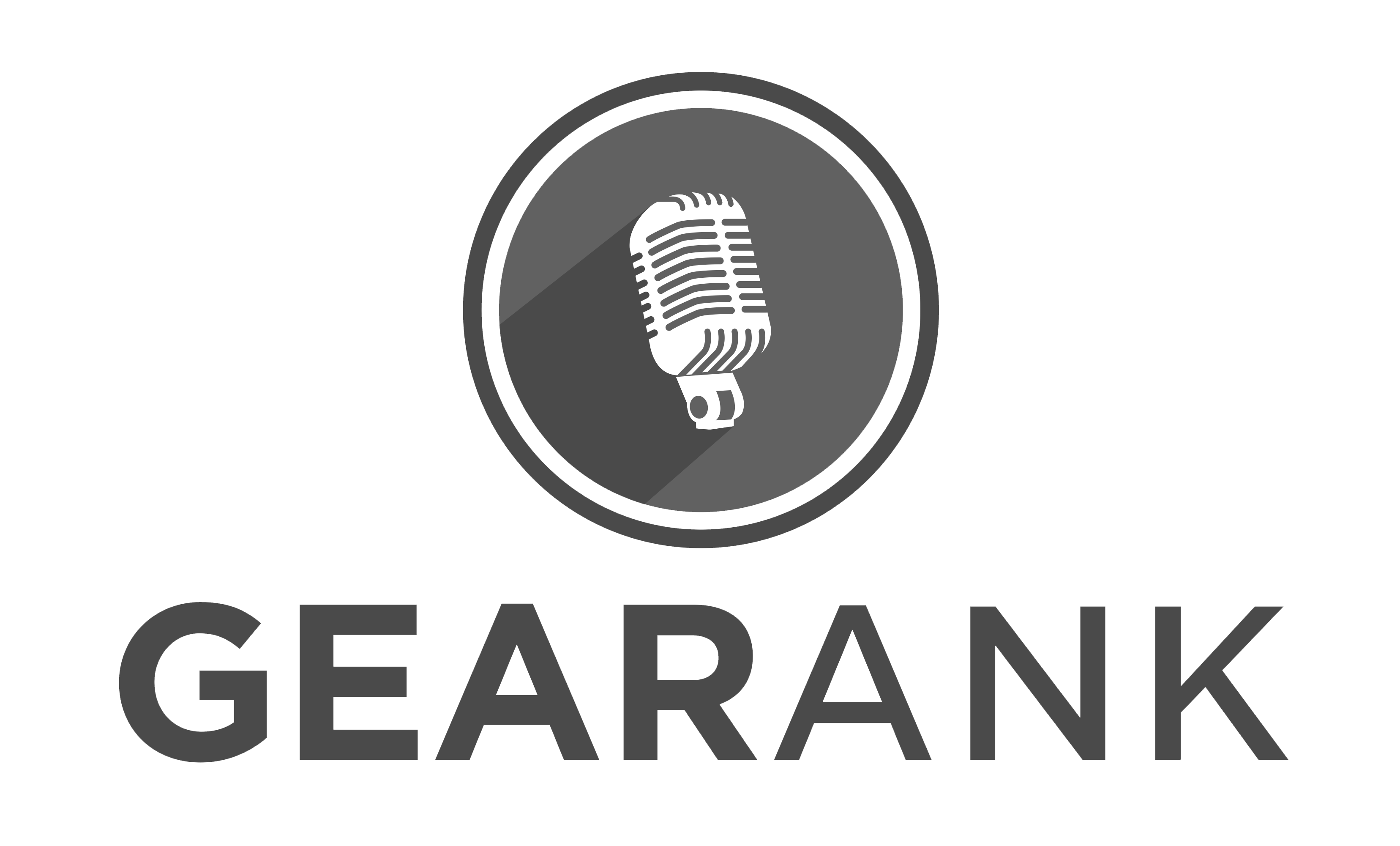
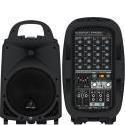
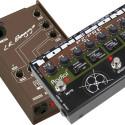

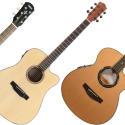
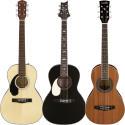
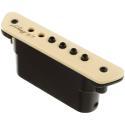
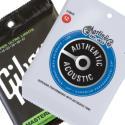
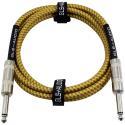
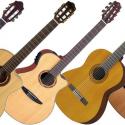
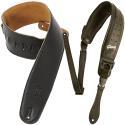

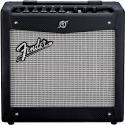
We have removed the Marshall AS50D from the recommended list due to it having been discontinued.
Today we removed the Donner DGA-1 due to it no longer being available.
Publication of our May 2022 Edition resulted in the following amps being removed from the recommended list above:
We have removed the Fender Acoustasonic 40 from the Under $200 section above due to a price increase.
The following amps came out of the guide above as part of our July 2020 update, but you can still see our analysis of them:
We’ve removed the following amp due to it being discontinued, but you can still read our analysis of it: Marshall AS100D.
I have the fishman loudbox artist. It’s okay sounding but the build quality is so bad I will never buy another fishman product. It’s made in China. And generally that should be okay. But after a couple of weeks of use the volume knob started making all sort of hiss and noise, and then after a couple of months the exterior of the cabinet starting peeling and crumbling. It’s made from some soft or spongy synthetic material. I’m getting rid of this and going for the Mesa Boogie.
As a result of our January 2019 update the following amps came off our recommended list above but you can still read our analysis of them:
What about the Mesa Boogie Rosette? How does it compare to the Fishman Loudbox Pro & AER?
The Mesa/Boogie Rosette Two:Eight made it onto our recommended list this year and it is currently the equal 2nd highest rated amp in the over 100 watt category along side the Fishman Loudbox Performer.
I’m not sure which one of the AER amps you’re referring to but you can see our ratings for their amps here.
Good info. I’m going a set from mic to speaker for my acoustic guitar.
What about the Crate Acoustics? i have seen used ones- how do they rate?
They didn’t make the short-list the last time we updated this guide, but if they are widely available in the USA when we next update then they might make the list.
As a result of the November 2017 update for this guide, the following amp was removed from our recommended list but you can still read our meta review of it: Behringer Ultracoustic ACX450.
Regarding schertler dealers in the USA. Django books in Seattle sells them and offers a 45 day return policy and free shipping. Generally when you call you’ll get the owner, Michael Horowitz, who always has impressed me as very intelligent and also knowledgeable about the products he sells
Sir… When I watching YouTube l was inspired by a TED x guy doing percussive guitar…Usman Riaz…he played guitar just only fingering on Fred board without striking strings… How can we amplify acoustic guitars like that…what are the effect pedals you preferred…can you please help me…I have no idea about it…please send me a email: vssebastian723@gmail.com
I’m not sure exactly which gear Usman Riaz uses, but a few years ago I asked a similar artist, Jon Gomm, what gear he used and he gave me a complete rundown in this article I wrote for GuitarSite.com: Jon Gomm Rig.
I hope that helps.
You’ve missed quite a lot of quality acoustic amps and the biggest speaker size you’ve reviewed is 8″. An 8″ speaker is never going to be enough for a large venue without DI no matter what your review says. An 8″ speaker imo is a practice amp! You’ll need a 12″ or a 15″ to play a big venue without DI. You simply can’t get a proper bass response out of an 8″ speaker. If you could then PA systems in clubs would have 8″ speakers!
What about:
• SWR Acoustic Amps (California, Strawberry, Natural, Baja)
• Genz Benz – Shen 150LT and Shen 300LT – much more than 100W!!
• Acoustic Image TEN2
• Trace Elliot/Acoustic TA100 / TA200
• Carvin AG300
Saying that, all of those amps above are quite expensive. How about a Trace acoustic TA50R ‘slaved’ to a Carlbro Sherwood Classic 100w (15″ speaker) – that rocks!
Or simply buy an acoustic preamp (pedal or rack) and plug it into a Mackie SRM450. That will blow away any amp in your review list……
Thanks for your feedback JazzyJ.
In all the large venues I’ve worked in from indoor halls to outdoor amphitheaters, either as a performer or in the tech crew, no acoustic amp would have been sufficient on it’s own. The standard practice in these situations is to either take a line-out (DI out preferably) or to mic the amp. In other words, in large venues the amp serves as an on-stage monitor where the PA and its Front of House stacks with large 15″ and sometimes bigger cones being used to provide most of the amplified sound for the audience.
I’m pretty sure that most of the amps you mentioned were included in our survey, but didn’t meet our availability criterion as mentioned in the Methodology section above or didn’t have high enough ratings to be short-listed. We’ve since relaxed the availability rule a bit to include manufacturers like Carvin which mostly sell direct so they will be included in our short-list when we next update this guide. Some of the other amps you mentioned are mostly available second hand and people can look for them on reverb or ebay, but I’ll make sure we check out the latest from those brands when we next update this guide.
Your idea about using an acoustic preamp in combination with a powered PA speaker is a good one – I see many acts in my area doing that or using a preamp and going direct to the PA these days.
Mesa Boogie is the only maker to post on there website the fact there acoustic amp is class d. This is a big deal for old school players who prefer transformer power. Shame on the other manufacturers for making it so hard to find out what’s inside.
How about the Rivera Sedona series? How do they stack up? Thanks, Eddie
We didn’t rate the Rivera Sedona dual electric/acoustic amps back when we first published this guide because there was only limited availability of them from US retailers at the time – possibly because they’re significantly more expensive than standard acoustic amps.
But thanks for asking the question – we’ll make sure to include Rivera Sedona in our music gear database when this guide is next updated – that may result in them being included in this guide given how highly they are spoken of by people that review or comment about their experiences using them.
It is very useful, but in my opinion would be better to have more precise gradation. If I can suggest groups could be divide to up to 30W, up to 80W, up to 120W and more than 120W.
Thank you dodo – we will take your suggestion into account when we update this guide – this kind of feedback is quite useful!
Guess you’ve never tried a Schertler
Hi Darrel,
The above report was not based upon personal preferences as your comment would seem to imply, rather it was based upon the criteria set out in the Methodology section above.
One of the criteria was that an amp had to be available at major online music gear retailers in the USA. At the time of publishing both this guide and this comment, Schertler amplifiers were not available at Guitar Center, Musicians Friend, zZounds, AMS, Sam Ash, B&H, or our sponsor Sweetwater.
It seems that in order to buy a Schertler amp online from within the USA you currently either have to go to an overseas music gear specialist such as Thonmann (31Kg/~68lbs shipping weight limit), or to a 3rd party seller via services such as Reverb, Amazon or eBay.
Before buying through any non-standard process, I would check with the manufacturer to see if I would get a valid warranty and where I would have to send the amp if it ever needed to be repaired.
BTW – if anyone does know of an authorized Schertler dealer in the USA, please leave a comment about them here.
Shoreline Music is a dealer for Schertler amps.
Where is the ZT Lunchbox Acoustic? Much more natural sound than the Fishman Mini, which it compares to in size, cost, and performance but not wattage. Wattage is subjective – it doesn’t always correlate to volume.
Thank you very much for asking about that Steve because you’ve given me the opportunity to explain what some people might have thought was an accidental omission on our part – it was not.
The ZT Amplifiers Lunchbox Acoustic failed to get past the first phase of our screening process because it had too many negative customer reviews, many of which complained about it not being loud enough for a 200 watt amp.
ZT Amplifiers chose to market the Lunchbox Acoustic using the higher Peak Musical Power rating of 200 watts instead of using the industry standard for guitar amps which is Root Mean Square (RMS). Had they chosen to promote it using a lower RMS power rating then it’s reasonable to think that it wouldn’t have attracted so many complaints about the lack of volume.
The net result was that the Gearank algorithm was only able to give the Lunchbox Acoustic a Gearank score of 78.
In the interests of transparency I have included the Lunchbox Acoustic in our public gear database so everyone can see its Gearank score along with all the other amps.
How does it compare with the others other than the issue of volume?
Hi John – at the current time we are only providing overall ratings with the Gearank algorithm, for now you’ll have to evaluate the Lunchbox Acoustic amp the old fashioned way by reading what users have to say in the comments here or on websites such as Harmony Central and Gearslutz.